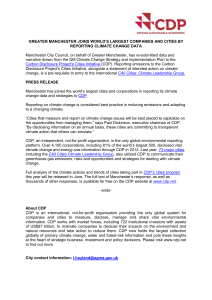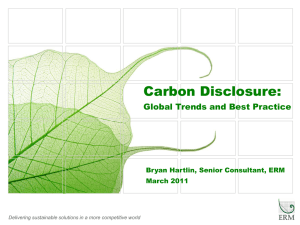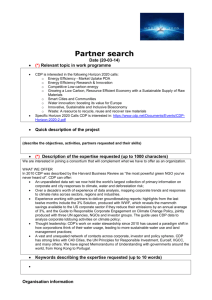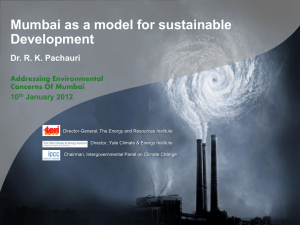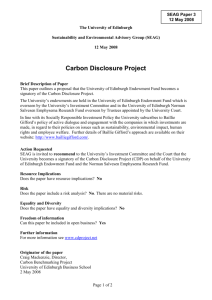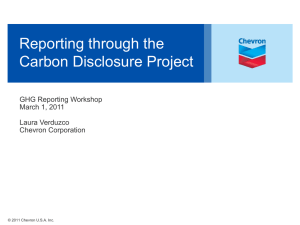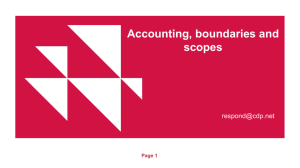Prosperity fund evaluation: CDP Cities in Korea 2013
advertisement
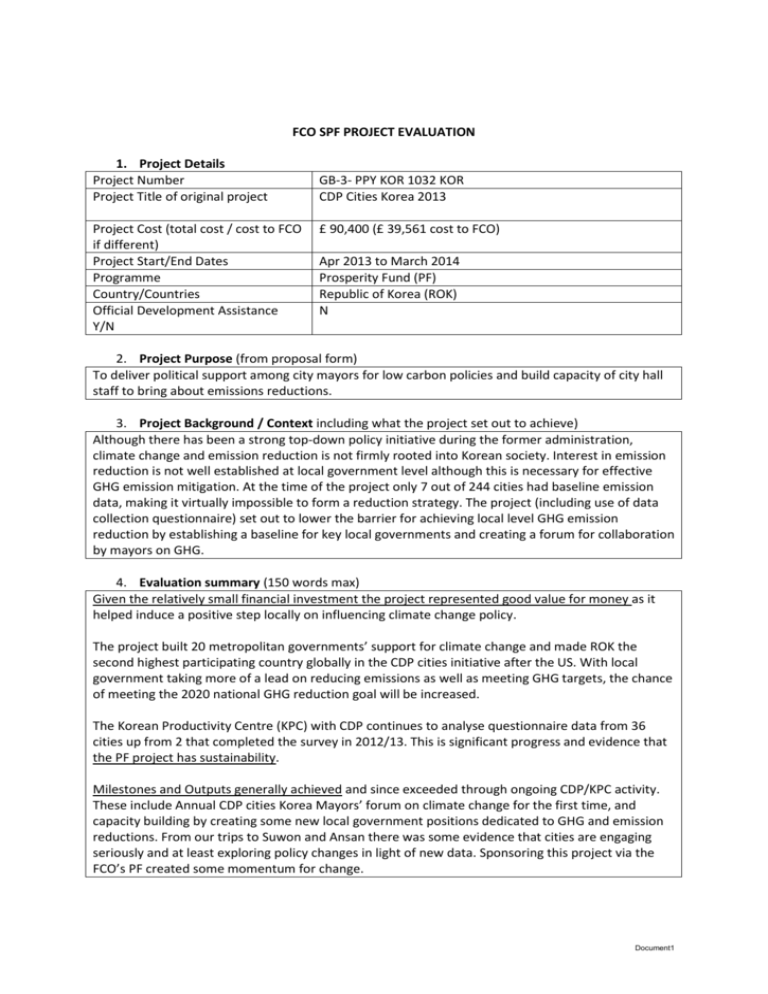
FCO SPF PROJECT EVALUATION 1. Project Details Project Number Project Title of original project Project Cost (total cost / cost to FCO if different) Project Start/End Dates Programme Country/Countries Official Development Assistance Y/N GB-3- PPY KOR 1032 KOR CDP Cities Korea 2013 £ 90,400 (£ 39,561 cost to FCO) Apr 2013 to March 2014 Prosperity Fund (PF) Republic of Korea (ROK) N 2. Project Purpose (from proposal form) To deliver political support among city mayors for low carbon policies and build capacity of city hall staff to bring about emissions reductions. 3. Project Background / Context including what the project set out to achieve) Although there has been a strong top-down policy initiative during the former administration, climate change and emission reduction is not firmly rooted into Korean society. Interest in emission reduction is not well established at local government level although this is necessary for effective GHG emission mitigation. At the time of the project only 7 out of 244 cities had baseline emission data, making it virtually impossible to form a reduction strategy. The project (including use of data collection questionnaire) set out to lower the barrier for achieving local level GHG emission reduction by establishing a baseline for key local governments and creating a forum for collaboration by mayors on GHG. 4. Evaluation summary (150 words max) Given the relatively small financial investment the project represented good value for money as it helped induce a positive step locally on influencing climate change policy. The project built 20 metropolitan governments’ support for climate change and made ROK the second highest participating country globally in the CDP cities initiative after the US. With local government taking more of a lead on reducing emissions as well as meeting GHG targets, the chance of meeting the 2020 national GHG reduction goal will be increased. The Korean Productivity Centre (KPC) with CDP continues to analyse questionnaire data from 36 cities up from 2 that completed the survey in 2012/13. This is significant progress and evidence that the PF project has sustainability. Milestones and Outputs generally achieved and since exceeded through ongoing CDP/KPC activity. These include Annual CDP cities Korea Mayors’ forum on climate change for the first time, and capacity building by creating some new local government positions dedicated to GHG and emission reductions. From our trips to Suwon and Ansan there was some evidence that cities are engaging seriously and at least exploring policy changes in light of new data. Sponsoring this project via the FCO’s PF created some momentum for change. Document1 5. Questions Did the project achieve the project purpose? Did the project come in on budget? (Y/N) If no, why and what was the difference in cost? Was the project completed on time? (Y/N) If not, why not? Were the Project benefits sustained after project completion? Yes Yes Yes Still unclear but would appear that implementers fully intend to make them so. 6. Overall Red / Amber / Green rating for project Overall Rating for project (put X in relevant box) Red Red Amber Amber Green X Green Guide to overall rating: Green- project performed well under each of the evaluation criteria: relevance, efficiency, effectiveness, sustainability, impact and management Green/Amber – project performed well under most criteria and adequately in others Amber/Red – project performed adequately under some criteria but poorly in others Red – project performed poorly under most criteria 7. Top 5 Lessons learned The quality of data return questionnaires is as important as the numbers received. Any future projects should, where possible, identify specific policy areas. The bottom up approach in influencing provincial city stakeholders is having some success and ideally should continue alongside the work at national level. Project proposal may have benefited from a short communication plan including implementer’s communication with mayors. Though key stakeholders were clearly identified. Though not in direct control of the Embassy, CDP may need to increase marketing to clarify their remit to targeted cities. A few cities confirmed that the incentive for them to join CDP is to increase their reputation. But how exactly CDP can help to increase their capacity on climate change and green growth and what the data tells them is still not entirely clear to them. The project timeframe and resources constrained efforts to offer follow up solutions to some questions arising out of the data. Managing expectations is important. Document1 8. Recommendations for future projects The project was experimental and the return on investment and direct, measurable benefits including to the UK not easy to measure especially in the short term, such benefits will be emphasised in future project proposals (as evidenced in recent 15/16 ROK strategy and PF bids). The next step could be to identify any specific local policy changes that may impact national policy and to attempt to link these to specific high value low carbon business opportunities. ROK accelerating domestic progress to a low carbon economy will continue to figure in the UK/ROK bilateral business plan and local prosperity strategy. As well as helping to create a policy environment in Korea where UK businesses can prosper. Targeted use of the FCO’s PF in support of this should be considered against other competing priorities. There is considerable interest from implementers (CDP and GCKN) to sustain this work. Other: City ‘champions’ (identified during this project) engagement plan and follow up could potentially be a very good use of PF. This would further enhance work to date. Success in ROK could serve as a useful example for others to follow in the region and beyond, and should be shared. Built in risk mitigation to cope with periodic personnel reshuffles in each city to be considered with implementers. Implementer clarification/initial feasibility of software use. To include strategy for getting buy in of newly elected mayors. Document1


